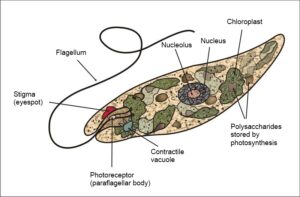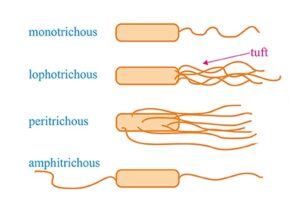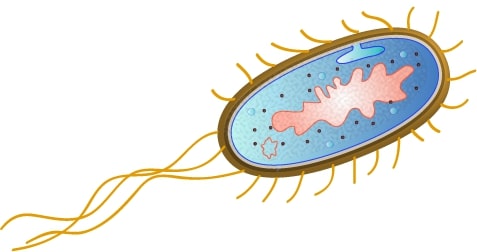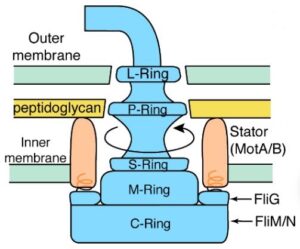Flagella aids in the locomotion or movement of the organisms. It is like a strand of hair that is attached to the surface of the cell and promotes motility.
The following are the types of flagella that we will discuss in this article.
What are mastigonemes?
Flagella are usually simple and plain. But few types of flagella have small hair-like structures on the lateral sides of them.
The tiny and minute hairs present on the sides of the flagella are called mastigonemes.

Image credits- Pixabay
Types of flagella in algae:
Algae are eukaryotic organisms that mostly live in water, they are photosynthetic organisms and has a nucleus inside them.
There are 2 types of flagella seen in algae.
Whiplash flagella:
A smooth thin tail like structure or projection that comes out of the cell. It is called as acronematic as the flagella do not have any minute hairs from it, that is the flagella is hairless. So the whiplash flagella of the algae is acronematic.
Tinsel flagella:
A minute thin hair like projection with minute hairs in them on both the sides and this is why tinsel flagella are also called pantonematic.
Read more on Eukaryotic cell examples
Types of flagella in Protozoa
Protozoa are single celled organisms which are eukaryotic organisms.
Usually 4 types of flagella is seen in protozoa
Stichonematic:
When the mastigonemes are present only at one side as a row, it is called a stichonematic flagellum.
Pantonematic:
When the mastigonemes are present on both the sides, it is called a pantonematic flagellum.
Acronematic:
When there is no hair-like structure that is no mastigonemes are present, they appear to have a smooth flagella and the terminal part have a fiber-like structure it is called acronematic flagella.
Simple flagellum :
Absence of mastigonemes and no fiber like structure found in the terminal part, it is a simple flagellum.
Types of flagella in Fungi
Fungi are eukaryotic organisms that are present in soil, water and dead matter. They are single celled or multicellular fungi are also present. They have flagella similar to algae.
There are 2 types of flagella seen in fungi.
Whiplash flagella:
A smooth thin tail like structure or projection that comes out of the cell. It is called as acronematic as the flagella do not have any minute hairs from it, that is the flagella is hairless. So the whiplash flagella of the algae is acronematic.
Tinsel flagella:
A minute thin hair like projection with minute hairs in them on both the sides and this is why tinsel flagella are also called pantonematic.
Types of flagella in Euglena
Euglena are small protists organisms that are mostly present in fresh water habitats. They are flagellated eukaryotic organisms.
Two flagella are seen in a euglena.
- The longer one is equal to the structure of the complete euglena, which is called the locomotory flagellum that is used for locomotion or movement.
- The non-emergent one, which is very short and does not protrude out of the cell.

Image credits- Wikimedia
Types of flagella in Bacteria
Bacteria are microscopic prokaryotic organisms that is present everywhere on this earth.
Bacterial flagella is of 5 types
Monotrichous:
Mono- Single; A single flagella present at any end or pole of the cell is called Monotrichous, which is also called Polar flagella.
Example: Vibrio cholera, Campylobacter spp., Caulobacter crescentus etc.
Peritrichous:
When the flagellum is present all over that is present fully on the surface of the cell, it comes under the category of Peritrichous flagella.
Example: E. coli, Bacillus subtilis, Salmonella, and Klebsiella.
Amphitrichous:
This is very similar to monotrichous flagella. One Flagellum is present at the both end or both poles.
Example: Alcaligenes faecalis
Lophotrichous:
When a bunch or group or cluster of flagella is present at one end it falls under the category of Lophotrichous flagella.
Example: Spirillum
Atrichous:
When there is no flagella present in the cell that flagella is absent, it is called Atrichous.
Example: Lactobacillus, Pasteurella.

Image credits- Wikimedia
Type of flagella in E.coli
Escherichia coli or also called E.coli is a gram-negative bacterium commonly found on the lower intestines of certain animals.
Peritrichous:
When the flagellum is present all over that is present fully on the surface of the cell, it comes under the category of Peritrichous flagella.

Image credits- Wikimedia
Type of flagella in Treponema pallidum
Treponema pallidum is a spirochete bacterium that is spiral in shape. It caused diseases like syphilis, yaws etc..
Treponema pallidum have a periplasmic flagella which is called the axial filament. It is present in between the outer and inner membrane that is on the periplasmic space and aids in motility like a corkscrew motion.
Type of flagella in Protists
Protists are single celled organisms that are diverse in nature. The flagella in protists are the one that is present in euglena.
Two flagella are usually seen.
- The longer one is equal to the structure of the complete protist sp, which is called the locomotory flagellum that is used for locomotion or movement.
- The non-emergent one, which is very short and does not protrude out of the cell.
Now we know about the types of flagella, we need to understand the structure of flagella.
Structure of a Flagella:
Flagella is a tail-like or hair-like structure that aids in movement.
Bacterial Flagella Structure
The flagella has a spiral or helical morphology that comprises proteins called the flagellin protein.
The flagella structure is separated into three parts:
Basal Body
- Basal Body is the region that is adhered to the cell membrane or cytoplasmic membrane or to the outer membrane of the cell basically.
- It consists of ring- like structures which are closely packed by proteins in pairs called MotB.
The rings are
- L-ring: Which is the outer ring attached in the outer lipo-polysaccharide layer, which are mostly found in gram positive bacteria.
- P-ring: Attached in the peptidoglycan layer of the cell.
- C-ring: Attached in the cytoplasm of the cell.
- M-S ring: Attached in the cytoplasmic membrane of the cell.

Image credits- Wikimedia
Filament
- The minute hair strand-like structure that comes out from the hook region.
Hook
- The hook is a wider region that is present at the end of the filament.
- It connects the filament to the protein in the tip or base.
- Gram positive bacteria have longer hooks in comparison with others.
What is the function or role of flagella in an organism?
- The main function of flagella is that they aid in the movement of the organism.
- They perform other functions like they play the role of sensory organs like detection of temperature and changes in pH.
- Certain organisms use their flagella to increase their rates of reproduction mostly in eukaryotic organisms.
- It aids in the virulence factor in flagellated pathogenic organisms.
Also Read:
- Hybrid species examples
- Does transcription occur in the nucleus
- Do bacteria have enzymes
- Monogenea characteristics
- Aerobic respiration stages
- Does fermentation occur in the mitochondria
- Do platelets have a nucleus
- Obligate parasites examples
- Amino acids in cytoplasm
- Does yeast have mitochondria

Hello, I am Sugaprabha Prasath, a Postgraduate in the field of Microbiology. I am an active member of the Indian association of applied microbiology (IAAM). I have research experience in preclinical (Zebrafish), bacterial enzymology, and nanotechnology. I have published 2 research articles in an International journal and a few more are yet to be published, 2 sequences were submitted to NCBI-GENBANK. I am good at clearly explaining the concepts in biology at both basic and advanced levels. My area of specialization is biotechnology, microbiology, enzymology, molecular biology, and pharmacovigilance. Apart from academics, I love gardening and being with plants and animals.
My LinkedIn profile-